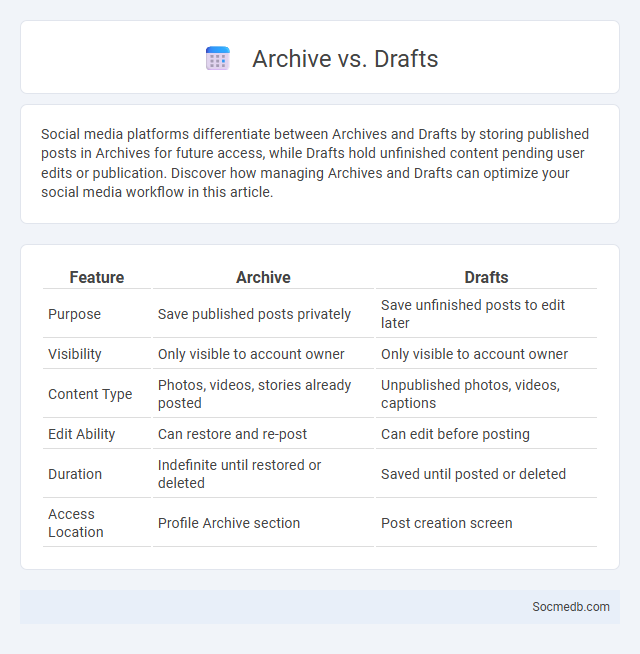
Photo illustration: Archive vs Drafts
Social media platforms differentiate between Archives and Drafts by storing published posts in Archives for future access, while Drafts hold unfinished content pending user edits or publication. Discover how managing Archives and Drafts can optimize your social media workflow in this article.
Table of Comparison
| Feature | Archive | Drafts |
|---|---|---|
| Purpose | Save published posts privately | Save unfinished posts to edit later |
| Visibility | Only visible to account owner | Only visible to account owner |
| Content Type | Photos, videos, stories already posted | Unpublished photos, videos, captions |
| Edit Ability | Can restore and re-post | Can edit before posting |
| Duration | Indefinite until restored or deleted | Saved until posted or deleted |
| Access Location | Profile Archive section | Post creation screen |
Understanding Archives: Definition and Purpose
Archives in social media refer to systematically stored collections of past posts, messages, and multimedia content that preserve historical digital interactions. Their purpose is to maintain a reliable record for reference, legal compliance, or cultural preservation, ensuring that valuable information remains accessible over time. By understanding how social media archives function, you can efficiently manage your digital footprint and retrieve important data when needed.
What Are Drafts? Key Characteristics
Drafts on social media are unpublished posts saved for future editing or scheduling, allowing users to refine content before sharing. Key characteristics include the ability to store text, images, or videos temporarily within the platform, easy access for modifications, and seamless transition to published status once finalized. Drafts enhance content management, enabling strategic planning and consistent posting schedules across platforms like Facebook, Instagram, and Twitter.
Archive vs Drafts: Core Differences
Archive stores your published social media posts, allowing you to hide them from your profile without deleting, preserving engagement data and comments for future reference. Drafts contain your unfinished or scheduled posts, letting you edit and finalize content before sharing it publicly. Understanding the distinction helps you manage Your content lifecycle effectively, improving workflow and maintaining a polished online presence.
When to Use Archive in Content Management
Using the Archive feature in social media content management is essential when you want to temporarily hide posts without deleting them permanently, preserving your content's integrity. You should archive content that no longer aligns with your current branding or marketing strategy but may have future relevance. Archiving helps maintain a clean and curated profile while allowing you to restore or review posts when needed for Your evolving social media strategy.
Drafts: Best Practices for Unfinished Work
Managing drafts on social media platforms ensures your unfinished work remains organized and easily accessible for future edits. You can optimize your content by regularly reviewing and refining drafts to maintain relevance and clarity. Proper use of drafts improves efficiency, allowing you to finalize posts that effectively engage your audience.
Benefits of Archiving Content
Archiving social media content preserves valuable digital assets for future reference, ensuring brand consistency and legal compliance. It enables seamless access to historical posts, facilitating data analysis and performance tracking over time. Effective content archiving supports reputation management by safeguarding against content loss during platform changes or account suspensions.
Common Mistakes with Drafts and Archives
Common mistakes with social media drafts include saving incomplete or outdated content, which risks publishing errors and confuses Your audience. Mismanaging archives by failing to organize or regularly review stored posts can lead to missed opportunities for repurposing valuable material and inefficient content strategies. Properly handling drafts and archives ensures smoother content scheduling and elevates Your overall social media effectiveness.
Archive and Drafts in Email Management
Archiving emails helps declutter your inbox by storing messages securely for future reference without deleting them. Drafts enable you to save incomplete emails, allowing you to revisit and edit content before sending important social media updates. Efficient management of archives and drafts ensures your communication remains organized and professional.
Choosing the Right Option: Archive or Draft?
Choosing between archiving or drafting your social media content depends on your content strategy and future needs. Archiving preserves posts for reference or retrieval while removing them from public view, ideal for seasonal or outdated updates. Drafts allow you to save incomplete posts for further editing, giving you control to polish your message before sharing it with your audience. Your choice impacts the organization and accessibility of your social media assets.
Optimizing Workflow: Archive and Draft Strategies
Optimizing your social media workflow involves implementing efficient archive and draft strategies to streamline content management. Regularly archiving older posts declutters your profile while preserving valuable content for future reference or reposting. Drafting content in advance allows you to maintain consistency, fine-tune messaging, and respond quickly to trends without compromising quality.
 socmedb.com
socmedb.com